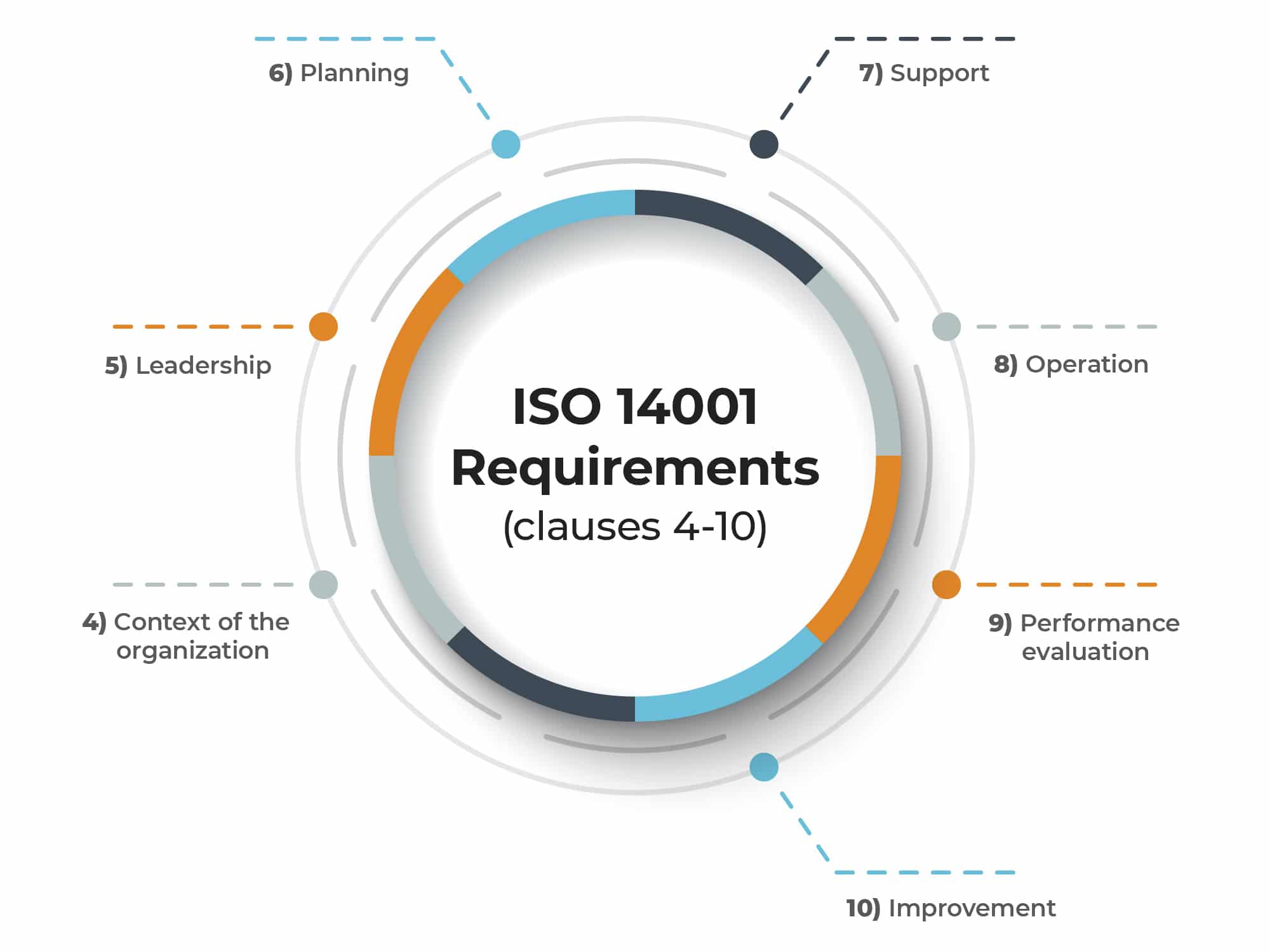The ISO 14001 requirements provide a set of standard elements that will guide in the implementation of an Environmental Management System (EMS). The requirements are designed to be applicable to any organization, regardless of its size, type, location, or level of maturity. All elements of the standard are mandatory, but the requirements stipulate the elements of an EMS that need to be covered, and the standard does not define how to address those requirements.
The ISO 14001:2015 requirements are broadly separated into 10 sections (called ISO 14001 clauses), with clauses one through three describing the standard and clauses four through 10 containing the requirements for an EMS: Context of the organization (clause 4), Leadership (clause 5), Planning (clause 6), Support (clause 7), Operation (clause 8), Performance evaluation (Clause 9) and Improvement (clause 10). Clauses 1 through 3 include no requirements, but instead deal with the scope of the standard, normative references to understand the standard better, and terms and definitions used in the standard.
5) Leadership
6) Planning
7) Support
8) Operation
9) Performance evaluation
10) Improvement
4. Context of the organization
This section deals with general requirements for an EMS including understanding your organizational context, the needs and expectations of interested parties for your EMS, and documentation of the scope of the Environmental Management System.
For an explanation on this topic, please see this article on Determining the context of the organization in ISO 14001.
5. Leadership
This section identifies the requirement for Top Management to demonstrate leadership and commitment to the EMS and identify the organizational roles, responsibilities, and authorities that will be present in the EMS. Leadership also includes the definition of the Environmental Policy that will act as the overall goal of the EMS. This policy must include a commitment to prevent pollution and to comply with all legal requirements to which the company is subject.
For some more details on the importance of the Environmental Policy, see How to write an ISO 14001 environmental policy.
6. Planning
The section on planning emphasizes the need to identify and plan to address risks and opportunities of the EMS, and how the processes of the organization interact with the environment (these are called environmental aspects), as well as how the company will keep up to date with legal requirements. The requirements also address the setting of objectives and planning to achieve them within the EMS.
For guidance on criteria for environmental aspect evaluation, this article is invaluable: ISO 14001:2015: How to set criteria for environmental aspects evaluation.
7. Support
This largest section addresses requirements on resources in the EMS, including the assessment of competence, training, and EMS awareness. Included in these requirements are how you will control documented information for the EMS as well as internal and external communication that is relevant to your EMS.
If you are struggling with measuring training effectiveness, see this article on Measuring training effectiveness in ISO 14001:2015.
8. Operation
While this is a small section, it is very important, as it sets the requirements on how you will plan for the control of your operations and how you will prepare and respond to emergency environmental situations.
If you are implementing operational control, this article can help: Defining and implementing operational control in ISO 14001:2015.
9. Performance evaluation
This second-largest section deals with how you will monitor, measure, analyze, and evaluate your EMS processes, including how you will evaluate compliance with legal requirements. A system of internal audits is mandated to make sure you audit your system performance to identify problems, and apply corrections for these problems. Finally, there are requirements on how management will review the EMS to ensure it is working and improving. Part of the review is to make sure adequate resources are applied to the EMS so that it can function properly.
For some more information on management review, see How can your EMS Management Review be more useful?
10. Improvement
The last section deals with requirements for how you will address nonconformity in your EMS processes, corrective actions needed for these nonconformities, and continual improvement activities for the occasions when you identify a problem before it occurs, or seek to make your processes better with respect to your environmental impact.
For some details on the corrective action process, see the article How to proceed once corrective action is initiated in the EMS.
Some Difficulties in Implementation
The greatest difficulty of implementing ISO 14001 is to ensure that the resulting collection of policies, procedures, processes, and records meet the needs of the company while still allowing improvement of the system. Improvement of the system is one of the main reasons for implementing an EMS, as it benefits the company in the long run.
For more detailed information on an ISO 14001 Environmental Management System download a free What is ISO 14001? white paper.

 Mark Hammar
Mark Hammar 






